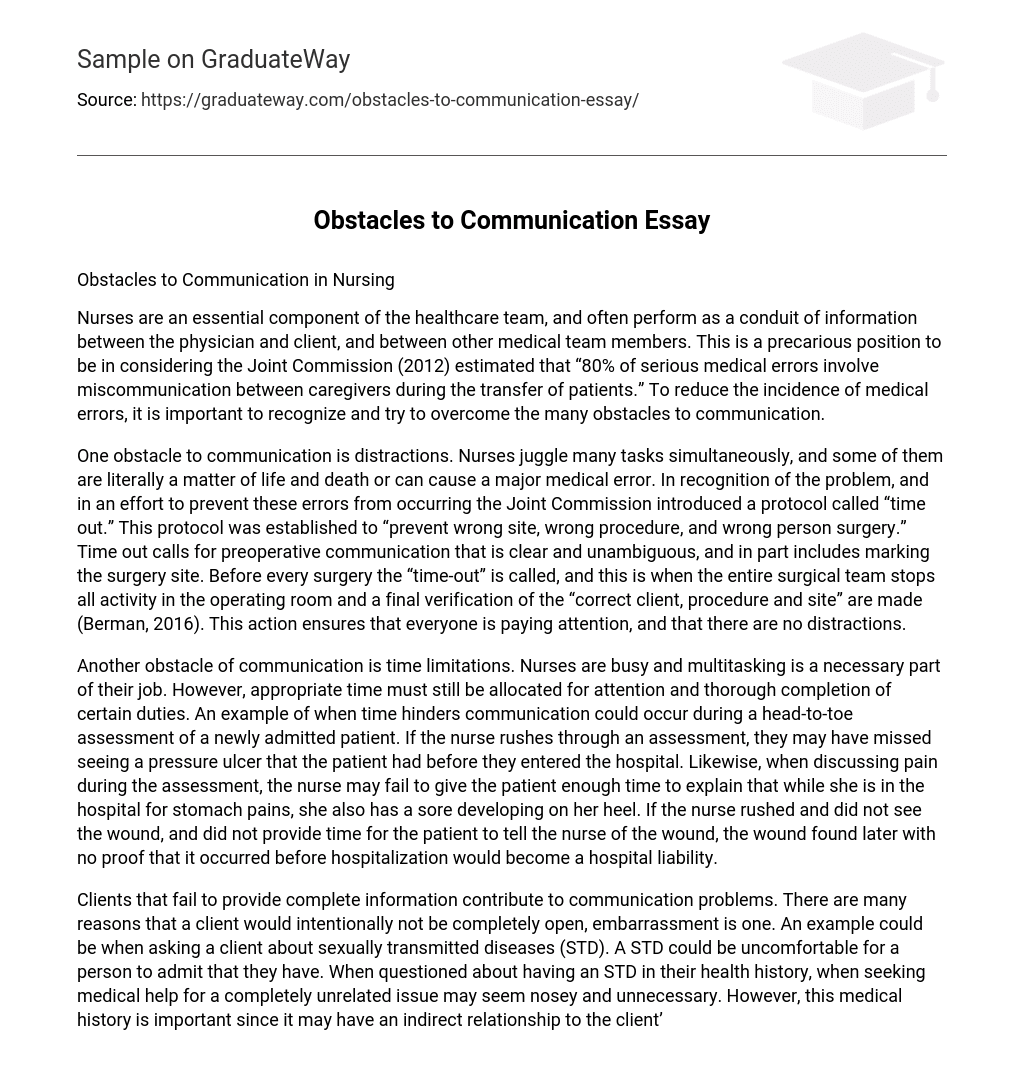Obstacles to Communication in Nursing
Nurses are an essential component of the healthcare team, and often perform as a conduit of information between the physician and client, and between other medical team members. This is a precarious position to be in considering the Joint Commission (2012) estimated that “80% of serious medical errors involve miscommunication between caregivers during the transfer of patients.” To reduce the incidence of medical errors, it is important to recognize and try to overcome the many obstacles to communication.
One obstacle to communication is distractions. Nurses juggle many tasks simultaneously, and some of them are literally a matter of life and death or can cause a major medical error. In recognition of the problem, and in an effort to prevent these errors from occurring the Joint Commission introduced a protocol called “time out.” This protocol was established to “prevent wrong site, wrong procedure, and wrong person surgery.” Time out calls for preoperative communication that is clear and unambiguous, and in part includes marking the surgery site. Before every surgery the “time-out” is called, and this is when the entire surgical team stops all activity in the operating room and a final verification of the “correct client, procedure and site” are made (Berman, 2016). This action ensures that everyone is paying attention, and that there are no distractions.
Another obstacle of communication is time limitations. Nurses are busy and multitasking is a necessary part of their job. However, appropriate time must still be allocated for attention and thorough completion of certain duties. An example of when time hinders communication could occur during a head-to-toe assessment of a newly admitted patient. If the nurse rushes through an assessment, they may have missed seeing a pressure ulcer that the patient had before they entered the hospital. Likewise, when discussing pain during the assessment, the nurse may fail to give the patient enough time to explain that while she is in the hospital for stomach pains, she also has a sore developing on her heel. If the nurse rushed and did not see the wound, and did not provide time for the patient to tell the nurse of the wound, the wound found later with no proof that it occurred before hospitalization would become a hospital liability.
Clients that fail to provide complete information contribute to communication problems. There are many reasons that a client would intentionally not be completely open, embarrassment is one. An example could be when asking a client about sexually transmitted diseases (STD). A STD could be uncomfortable for a person to admit that they have. When questioned about having an STD in their health history, when seeking medical help for a completely unrelated issue may seem nosey and unnecessary. However, this medical history is important since it may have an indirect relationship to the client’s present problem, or the doctor may prescribe treatment that would negatively affect the STD treatment. To promote open health discussions, nurses should reassure clients that medical information is used to help the physician make a diagnosis, and ensure the best treatment option is provided.
Patient Demographics
Patient demographics are also obstacles for nurses when communicating. Most healthcare systems have tried to incorporate cultural competence, or the sensitivity to patient’s values and beliefs into their practice. They have done this by employing a diverse staff, providing information in various languages, and having qualified compensated translators available.
Translators may not always be present during the office visit and telephonic translation services have been used as the option to overcome this obstacle. However, for languages that are “rare” there may be no words equivalent to the medical term being used, so interpreters may “inconsistently use paraphrasing and description to make meaning transfer, increasing confusion for the patient” (Ortiz and Casey, 2017). Additionally, a different translator may be used each time, which means that the interpreters may be from different levels of education with different accents and they may use words differently. The use of a telephonic translating service can be an answer to overcoming an obstacle, but it can also present new obstacles when the patient and medical profession become confused due to inconsistency of the translation. Situations where accurate translation is accomplished can be complicated by a patient who themselves cannot understand what is being told to them, and have a deficient health knowledge.
There are many obstacles to communication in nursing. Some of the obstacles can be overcome by giving more undivided time to the patient or task being completed, while other obstacles can be overcome by giving the patient more information to help them understand the purpose of what is being asked of them. However, some obstacles exist with regard to the specific needs of different demographics, such as language barriers. While language barriers have been overcome with employing a diverse and bilingual staff, not all cultures are represented in most medical facilities. Attempts to use telephonic translation have been helpful, but obstacles still exist.





